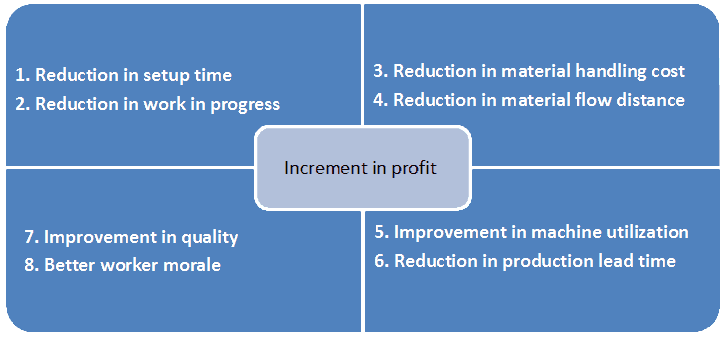Advantages of cellular manufacturing compared to traditional manufacturing by efficient layout design are depicted in figure 1 and explained as follows.

Figure 1: Advantages of cellular manufacturing
1. Reduction in setup time
Setup time is defined as period required preparing a device, machine, process or system to be ready to function or accept a job. Manufacturing cells are designed to process parts having similar shapes and relatively similar sizes. So it is not required to change or adjust machines and tools within cells to process similar parts. Thus setup time is greatly reduced in cellular manufacturing.
2. Reduction in work in progress
Work in progress refers to all materials and partly finished products that are at various stages of the production process. Work in progress excludes inventory of raw materials at the start of the production cycle and inventory of finished products at the end of the production cycle. With reduced setup times, the amount of work in progress can be reduced. Work in progress can be reduced by 50% when the setup time is cut in half.
3. Reduction in material handling cost and time
Material handling is the art and science of moving, storing, protecting and controlling material at the lowest possible cost through the use of proper method and equipment. Hundreds and thousands tons of materials are handled daily requiring the use of large amount of manpower, while the movement of materials takes place from one processing area to another or from one department to another department of the plant.
If proper method is not employed in material handling then total manufacturing cost & time is significantly increased. In cellular manufacturing, each part is processed completely within a single cell (where possible) which reduces part travelling distance & time. Almost no effort is needed in cellular manufacturing to store, protect and control materials. In cellular manufacturing, machines are close together under one or more workers in each cell. Thus it becomes easy to move materials from one machine to another. Reduction in work in progress also reduces material handling cost in cellular manufacturing.
4. Reduction in material flow distance
Material flow distance is defined as total distance travelled by all parts/materials to manufacture a single product or a variety of different products. By reducing it we can significantly reduce total manufacturing cost & time. Material flow distance is low in cellular manufacturing because every parts travel only in a small area (cell). In each cell, machines are close together. By efficient layout design of machines in each cell, 30 to 70% reduction in material flow distance can be achieved.
5. Improvement in machine utilization
In cellular manufacturing, single machine can be used to manufacture one or more products in each cell. Unnecessary machines are identified and removed from the manufacturing process. Reduction in setup time also reduces idle time for machines thus machine utilization is improved in cellular manufacturing.
6. Reduction in production lead time
Production lead time is defined as period between receipt of an order and until when it is available for packing or shipment. Production lead time is reduced in cellular manufacturing because of reduction in setup time, reduction in work in progress, reduction in material handling time, reduction in material flow distance and improvement in machine utilization.
7. Improvement in quality
In cellular manufacturing, most or all operations occur in one area and among a small team. This focuses responsibility and motivates the team to avoid similar defects in the future. Feedback on quality problems is faster and surer thus quality is improved in cellular manufacturing.
8. Better worker morale
By achieving all above listed advantages of cellular manufacturing, manufacturing industry profit increases more and more day by day and because of increment in profit, worker will get high incentive (bonus) apart from salary. Manufacturing processes become simple in cellular manufacturing. High incentive and simplified manufacturing processes boost worker morale.
